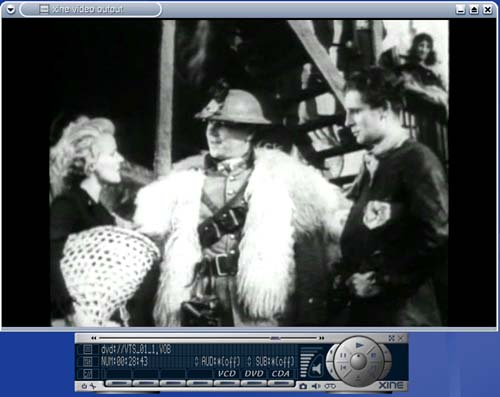Lights, Camera, Action: Moving Pictures
| Believe it or not, you have already worked with one of the Linux video players in this chapter. It is Noatun, KDE's media player. It is just as adept at playing video clips, such as AVI or MPEG files. Try it! If you have a DVD player installed on your system, you will likely want to take advantage of it. One of the more popular and slick-looking video players out there is xine. xine plays back video clips (such as AVI, MOV, or MPEG) and DVDs, as well. It can even handle URLs, meaning that you can play remote files on the Internet. You can start xine from your Multimedia menu (command name xine) or by calling the command directly. Looking at Figure 17-19, you'll see xine's basic interface. Most of the buttons are pretty self-explanatory (play, forward, rewind, etc.). Others allow you to switch to full-screen mode. To see what everything does, move your mouse cursor over the various buttons, and tool icons and a helpful tooltip will appear. Figure 17-19. xine's main controls are very approachable.
Now sit back and watch a movie (Figure 17-20)! Figure 17-20. Watching a movie on Linux with xine.
For more information on Linux videos and DVDs, visit the Linux Video Project at http://www.linuxvideo.org/. A Note on Encrypted DVDsYou may find as you play DVDs on your Linux system that some DVDs work and others do not. The reason for this is encryption. In an effort to protect against unlawful copying and distribution of movies on DVD, some companies in the motion picture industry have gone to extremes to protect themselves using a system called Content Scrambling System (CSS). The result of this overreaction curtails the freedom of those law-abiding individuals who are looking to play the DVDs that they legally bought and paid for on the DVD player that they legally bought and paid for on the computer they legally bought and paid for. "There's a simple solution," you say. "Why not write or use software that decrypts the DVDs so you can watch them?" Well, it isn't that easy. In some countries, most notably the United States, it is illegal to use software that decrypts any form of encryption put in place by another individual or company, even when it is for private use (do a Google search on DMCA). As I write this, legal challenges to this law are currently in the courts and in some cases, have already upheld the right of the individual. This isn't to say that the motion picture industry will give up easily. For instance, under the DMCA, a small handful of individuals have been charged for distributing a piece of software called libdecss, libdvdcss (or simply DeCSS), which lets you play encrypted DVDs on your Linux PC. The California Appeals Court ruled that the posting of source code (in this case, DeCSS) is upheld by the First Amendment. Meanwhile, in Norway, a young man named Jon Lech Johanson was cleared of wrongdoing for distributing DeCSS software on the Internet. The 19-year-old "DVD Jon" faced two years in prison when the Motion Picture Association of America (MPAA) requested that Jon be arrested (he was only 15 at the time). In fact, the MPAA wanted both Jon and his father arrested. Why am I telling you all this? I mention all of this because I want you to make yourselves aware of the laws in your area. Playing a DVD on your PC sounds like a perfectly normal and legal thing to do I agree, but I must repeat myself you should be careful and make yourselves aware of the laws regarding this as they apply to your state, province, or country. I don't want to hear that any of you are facing jail time just because you decided to watch your legal copy of the latest blockbuster on your Linux system. |
EAN: 2147483647
Pages: 181

